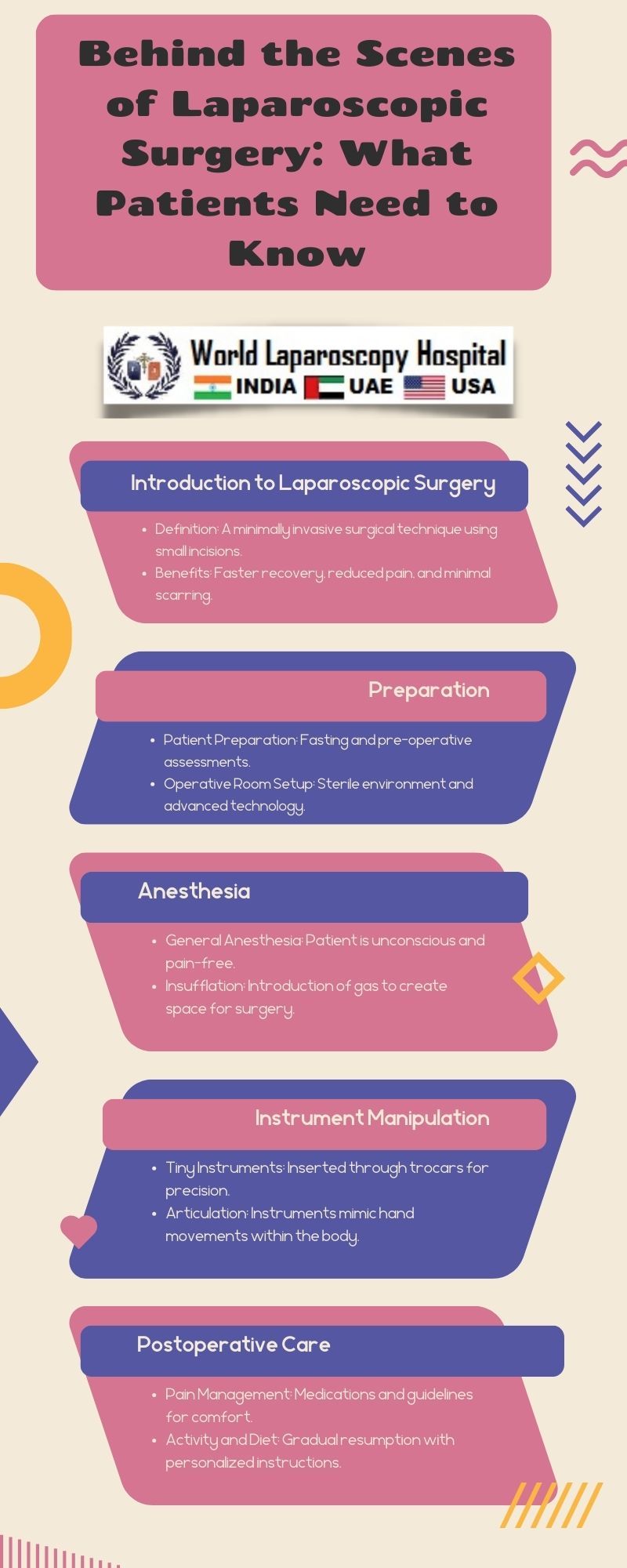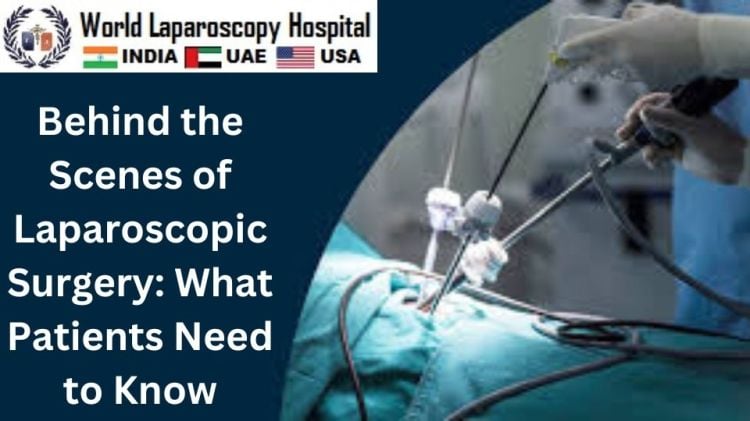Behind the Scenes of Laparoscopic Surgery: What Patients Need to Know
Introduction
Laparoscopic surgery, also known as minimally invasive surgery, has revolutionized the field of medicine, offering patients a less invasive alternative to traditional open surgeries. This innovative technique involves making small incisions and using specialized instruments and a camera to perform surgical procedures. While patients may only experience the outcome of the surgery, there's a fascinating world behind the scenes of laparoscopic surgery that contributes to its success. In this article, we'll delve into the intricacies of laparoscopic surgery, providing patients with valuable insights into what happens behind the operating room doors.

The Evolution of Laparoscopic Surgery
Before we explore the behind-the-scenes details, it's essential to understand the evolution of laparoscopic surgery. The technique originated in the early 20th century, with the first recorded laparoscopic procedure performed in 1901. However, it wasn't until the 1980s that laparoscopic surgery gained widespread acceptance.
Advancements in technology, including the development of high-resolution cameras and precision instruments, have played a crucial role in the evolution of laparoscopic surgery. The transition from traditional open surgery to minimally invasive techniques has been driven by the desire to minimize patient trauma, reduce recovery times, and enhance overall surgical outcomes.
The Operating Room Setup
Behind the scenes of laparoscopic surgery, meticulous planning and preparation occur long before the patient enters the operating room. One key aspect is the setup of the surgical suite, which includes specialized equipment tailored to laparoscopic procedures
-
Trocar Placement:
- Trocars are specialized instruments used to create access points for the insertion of surgical instruments and the camera. Proper trocar placement is critical for optimal visualization and maneuverability during surgery.
- Surgeons carefully plan the location of trocar entry points based on the specific procedure and patient anatomy.
-
Insufflation:
- Before surgery begins, the abdominal cavity is filled with carbon dioxide gas to create a working space for the surgical instruments. This process, known as insufflation, provides the surgeon with a clear view of the operative area and allows for easier instrument manipulation.
-
Patient Positioning:
- The patient's position on the operating table is crucial for the success of laparoscopic surgery. Surgeons carefully position the patient to optimize access to the target area while ensuring the patient's safety and comfort.
The Role of the Laparoscope
At the heart of laparoscopic surgery is the laparoscope, a thin, flexible tube equipped with a high-resolution camera. This instrument serves as the surgeon's eyes inside the body, transmitting real-time images to a monitor in the operating room.
-
Optics and Illumination:
- Laparoscopes are equipped with advanced optics and lighting systems to provide a clear and magnified view of the surgical site.
- Surgeons rely on the laparoscope to navigate through the intricate structures of the body with precision.
-
Camera Control:
- Behind the scenes, a surgical assistant or a robotic system often controls the movement and orientation of the laparoscope. This dynamic allows the surgeon to focus on instrument manipulation while maintaining a clear view of the operative field.
Instrumentation and Technique
Laparoscopic surgery involves the use of specialized instruments designed for precise movements within the confined space of the body. These instruments mimic the movements of the surgeon's hands, allowing for intricate maneuvers.
-
Articulating Instruments:
- Behind the scenes, surgical teams meticulously select and prepare articulating instruments that provide a wide range of motion. These instruments are inserted through the trocars and manipulated by the surgeon from the console.
-
Energy Devices:
- Laparoscopic surgery often requires the use of energy devices such as electrocautery and lasers. These devices enable surgeons to cut, coagulate, and dissect tissues with minimal bleeding.
-
Suturing and Stapling:
- Suturing and stapling in laparoscopic surgery involve specialized instruments that allow the surgeon to close incisions or secure tissues with precision. This step is crucial for achieving optimal postoperative outcomes.
Challenges and Innovations
While laparoscopic surgery offers numerous advantages, it is not without its challenges. Surgeons face limitations in dexterity and tactile feedback compared to open surgery. However, ongoing innovations aim to overcome these challenges and further improve the field.
-
Robotic Assistance:
- Robotic systems, such as the da Vinci Surgical System, have emerged as a game-changer in laparoscopic surgery. These systems provide surgeons with enhanced precision, 3D visualization, and improved dexterity through robotic arms controlled from a console.
-
Augmented Reality:
- Augmented reality technologies are being integrated into laparoscopic procedures to enhance the surgeon's view. Virtual overlays on the monitor can provide additional information, such as anatomical landmarks and critical structures.
-
Miniaturization of Instruments:
- Ongoing efforts in instrument miniaturization aim to further reduce the invasiveness of laparoscopic procedures. Smaller instruments can enhance maneuverability and minimize trauma to surrounding tissues.
Postoperative Care and Recovery
Behind the scenes, the surgical team collaborates to ensure a smooth transition from the operating room to the recovery phase. Postoperative care is a critical aspect of the laparoscopic surgical process.
-
Monitoring and Observation:
- Patients are closely monitored in the recovery room to assess vital signs, pain levels, and any signs of complications.
- The surgical team collaborates with nursing staff to ensure a seamless transition from the operating room to the recovery area.
-
Pain Management:
- Effective pain management is essential for the patient's comfort and recovery. The surgical team works with anesthesiologists and pain management specialists to develop a personalized pain management plan.
-
Early Ambulation and Rehabilitation:
- Behind the scenes, healthcare professionals encourage early ambulation and rehabilitation to expedite the recovery process. Physical therapists may be involved to guide patients through exercises that promote healing and prevent complications.
Patient Education and Informed Consent
In the realm of laparoscopic surgery, patient education and informed consent play pivotal roles. Behind the scenes, healthcare providers engage in comprehensive discussions with patients to ensure they understand the procedure, potential risks, and expected outcomes.
-
Informed Consent Process:
- Surgeons and healthcare providers explain the nature of the laparoscopic procedure, including the expected benefits and potential risks.
- Patients are informed about alternative treatment options and have the opportunity to ask questions before providing their informed consent.
-
Preoperative Counseling:
- Before the surgery, patients receive preoperative counseling to address any concerns and prepare them for the postoperative period.
- Clear communication between healthcare providers and patients is crucial for establishing realistic expectations and ensuring a positive surgical experience.
Conclusion
Laparoscopic surgery has transformed the landscape of modern medicine, offering patients a less invasive approach to a wide range of surgical procedures. Behind the scenes, a symphony of coordination and precision takes place to ensure the success of laparoscopic surgeries. From the strategic placement of trocars to the careful manipulation of instruments and the integration of cutting-edge technologies, the world behind laparoscopic surgery is a testament to the remarkable strides in medical innovation.


